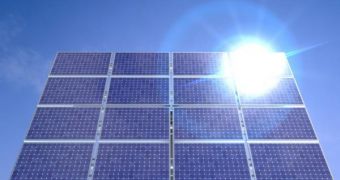When talking about solar cell efficiency, even a rise of 1 percent, which to some may appear modest, is reason for researchers to celebrate. The previous solar cell conversion efficiency was averaging 21.9 percent. A new world record for solar cell efficiency has been set on Wednesday by a team of researchers from the Eindhoven University of Technology in collaboration with colleagues from the Fraunhofer Institute, who achieved a relative improvement of 6 percent, bringing the overall average solar cell efficiency to 23.2 percent.
This was accomplished by creating a design that uses an ultra-thin aluminum oxide layer in front of the cell. Solar cell efficiency improvement eventually translates into a drop in solar energy production costs, further facilitated by the fact that the application of aluminum oxide layers can be achieved with relatively low expenses.
The ultra-thin layer, measuring only 30 nanometers in thickness, is deposited directly onto the crystalline silicon solar cell, helping the build up of negative charges on the layer, and eliminating energy loss. By doing so, about 23.2 percent of the solar energy radiated on the surface of the cell is converted directly into electric energy.
The study was led by physicist Bram Hoex from the Endhoven University of Technology, who got his PhD at the Applied Physicist department just last week with the help of his research project. Hoex was assisted in his study by professor Richard van de Sanden and Erwin Kessel, both from the Plasma & Materials Processing research group, which is specialized in plasma deposition of extremely thin layers.
The same process had been licensed in 2001 by the OTB Solar Dutch company and is now used by numerous solar cell manufacturers around the world as standard production process.
Solar cells present high interest in the energetic domain, since they promise to solve most of the problems related to energy. Daily, The Sun radiates a massive amount of energy to the surface of the planet, which can be converted directly into electric energy. Although most of the solar cells used today have a relatively low efficiency, they could become competitive with other conventional means of producing electric energy in as little as ten to fifteen years, an opportunity that developing countries with high levels of sunshine could exploit.

 14 DAY TRIAL //
14 DAY TRIAL //